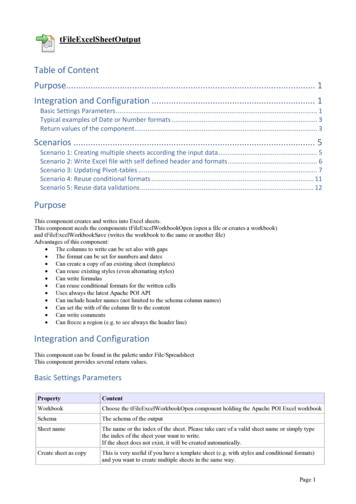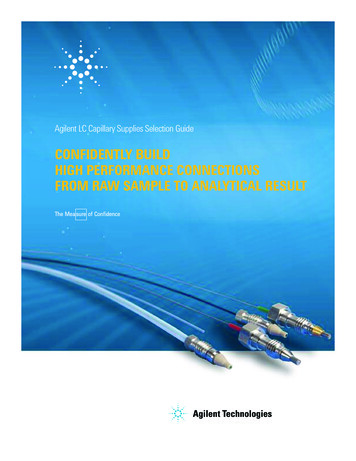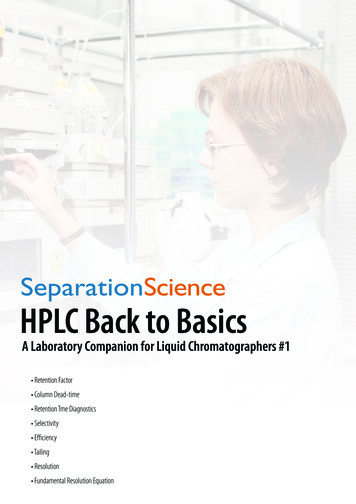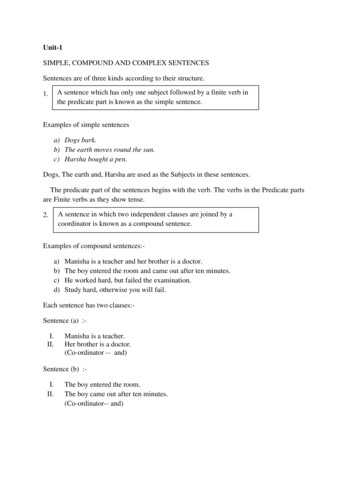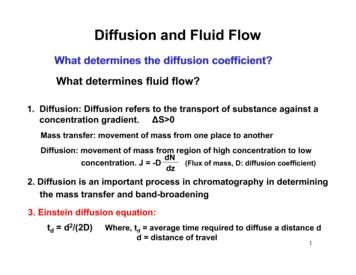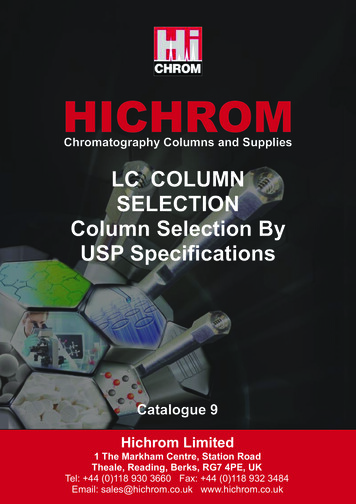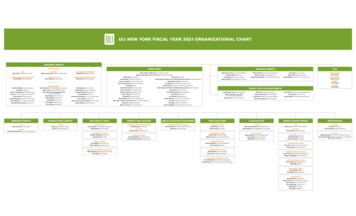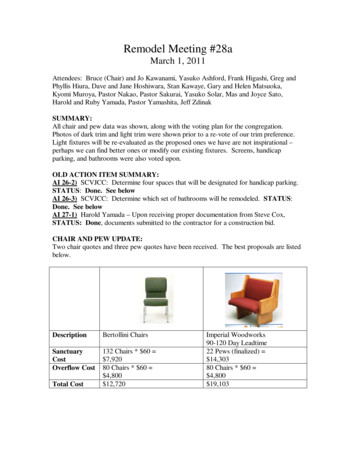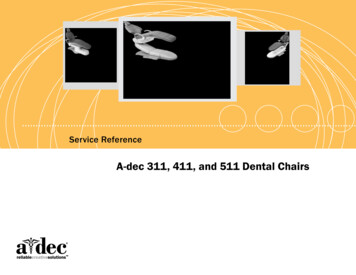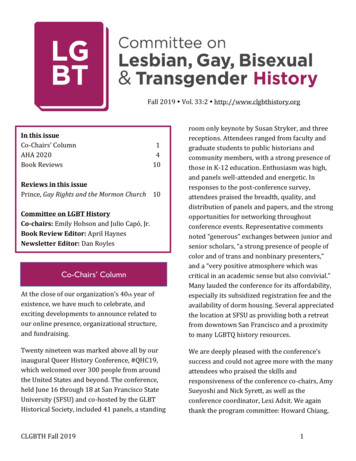
Transcription
Fall 2019 Vol. 33:2 http://www.clgbthistory.orgAt the close of our organization’s 40 th year ofexistence, we have much to celebrate, andexciting developments to announce related toour online presence, organizational structure,and fundraising.room only keynote by Susan Stryker, and threereceptions. Attendees ranged from faculty andgraduate students to public historians andcommunity members, with a strong presence ofthose in K-12 education. Enthusiasm was high,and panels well-attended and energetic. Inresponses to the post-conference survey,attendees praised the breadth, quality, anddistribution of panels and papers, and the strongopportunities for networking throughoutconference events. Representative commentsnoted “generous” exchanges between junior andsenior scholars, “a strong presence of people ofcolor and of trans and nonbinary presenters,”and a “very positive atmosphere which wascritical in an academic sense but also convivial.”Many lauded the conference for its affordability,especially its subsidized registration fee and theavailability of dorm housing. Several appreciatedthe location at SFSU as providing both a retreatfrom downtown San Francisco and a proximityto many LGBTQ history resources.Twenty nineteen was marked above all by ourinaugural Queer History Conference, #QHC19,which welcomed over 300 people from aroundthe United States and beyond. The conference,held June 16 through 18 at San Francisco StateUniversity (SFSU) and co-hosted by the GLBTHistorical Society, included 41 panels, a standingWe are deeply pleased with the conference’ssuccess and could not agree more with the manyattendees who praised the skills andresponsiveness of the conference co-chairs, AmySueyoshi and Nick Syrett, as well as theconference coordinator, Lexi Adsit. We againthank the program committee: Howard Chiang,In this issueCo-Chairs’ ColumnAHA 2020Book Reviews1410Reviews in this issuePrince, Gay Rights and the Mormon Church 10Committee on LGBT HistoryCo-chairs: Emily Hobson and Julio Capó, Jr.Book Review Editor: April HaynesNewsletter Editor: Dan RoylesCo-Chairs’ ColumnCLGBTH Fall 20191
René Esparza, Will Kuby, Amanda Littauer,Kirsten Leng, Víctor Macías-González, JenManion, Wendy Rouse, Nikita Shepard, YorickSmaal, T.J. Tallie, and Sarah Watkins. Accordingto the post-conference survey, areas forimprovement centered primarily aroundaccessibility, A/V support, and the need for agreater number of gender-neutral bathrooms.We appreciate this and all feedback and committo addressing these issues moving forward.We are excited to repeat the Queer HistoryConference and propose to continue it as abiennial conference held in odd-numbered years.Based on feedback from Amy and Nick, we planto again hold the conference in San Francisco—save the date, June 2021—with the goal ofrotating to other cities beginning in 2023. Whilewe have many reasons for hosting theconference in San Francisco again in 2021, weare especially appreciative for the institutionalsupport Amy has been able to provide throughSFSU. We will solicit a new program committeeearly in 2020 and issue a Call for Papers laterthat year. Looking ahead to #QHC23, we will alsoaccept bids for host institutions and cities.Beyond QHC, we continue to work on growingthe CLGBTH, including through our onlinepresence. Our newsletter has been a popular,well-read venue for book, film, and exhibitreviews, as well as calls for conferences andprizes and our seasonal co-chairs’ column. But inrecent years, most members have opted toreceive the newsletter digitally rather than onpaper, and many request more frequent updatesto our website. As a result, we are moving thenewsletter content fully online beginning inJanuary 2020. In consultation with our outgoingwebmaster, newsletter editor, and the governingboard, we have merged newsletter and websiteCLGBTH Fall 2019labor into a new role of website editor, helpingus relay information to members and supportersmore quickly, with less expense, and withoutusing paper or ink. Our website format will alsobe better integrated with our social mediaplatforms, which we hope to continue to grow.As a part of this transition, please join us inwelcoming two new incredible talents to ourteam. As our inaugural website editor who canlead our strategic shift to digital, we haverecruited Kevin C. Quin, a Cornell Universitydoctoral student in Africana Studies and LGBTQStudies. Kevin is a skilled, public-facing scholarwith an extensive digital presence, especiallythrough Black Perspectives, the African AmericanIntellectual History Society blog. We are alsomost fortunate that Caroline Radesky, a visitingAssistant Professor at the University of Iowa, hasaccepted our invitation to serve as our ReviewEditor. This position, slightly reconceived fromthe previous position of book review editor, willhelp us continue to broaden the breadth andscope of reviews to include pedagogical works,films, museum exhibitions, and more. Since thenewsletter will exist entirely online, reviews willbe posted exclusively to our website, with theopportunity to publish them throughout theyear. Caroline’s strengths in the history ofgender, feminism, and sexuality, especially hertransnational approach and her unpacking oftranshistoricity, will no doubt be invaluableassets to our field and the CLGBTH’s newinitiatives. Welcome, Kevin and Caroline!Of course, all this news is a bit bittersweet, as itmeans we say goodbye to other talented,generous, and committed colleagues who arecycling out of roles in the CLGBTH. We aredeeply indebted to the time and efforts ofAndrew Ross, who served as our webmaster for2
nearly five years—generously extending histenure to ease our own entry as co-chairs. DanRoyles, who is also a member of our currentgoverning board, will cycle out of his otherposition as newsletter editor. Dan workedclosely with April Haynes, our recent bookreview editor, who has added so much to theorganization’s vision. As co-chairs, we cannotstress enough how thankful we are to Andrew,Dan, and April, who have dedicated countlesshours to making the CLGBTH better for all of us.Your generosity of spirit, time, and energy hasbeen invaluable.We are also happy to report that, in consultationwith the governing board, we are in the processof creating a new administrative position: aCLGBTH executive director. Many otherorganizations—both large and small—have arole like this in place. This position will notreplace or supersede the co-chair or governingboard duties, and to maintain the will of ourmembers who elect the co-chairs and membersCLGBTH Fall 2019of our governing board, the executive directorwill not have voting power. Instead, this newposition will allow us to consolidate many of thetasks of the secretary-treasurer—a rolecurrently filled by Emily Skidmore, who we aremost fortunate to have on board. The reason forcreating an executive director position is toensure that we retain greater institutionalmemory and consistent financial andorganizational practices amidst the turnover ofco-chairs and members of the governing board.The executive director will hold a longer-termlimit (five years) and as a result will help easeleadership transitions.On the heels of the success of our inauguralQueer History Conference, we will soonannounce plans for an ambitious fundraisingcampaign. While we have been successful atgrowing our quite modest coffers over the pastcouple of years, we remain committed toredistributing those funds to those who need itmost and find new ways of supporting those3
whose talents and efforts keep our field andprofession so strong. We hope to launch a capitalcampaign to help us provide meaningfulresearch and travel grants in perpetuity. In themeantime, we ask you to make a donation of anyamount to help us live up to our name andmission of growing LGBTQ history and politics.Finally, we look forward to seeing many of you atthe 2020 meeting of the American HistoricalAssociation—#AHA20—where we will hold 17panels on a wide range of topics, as well as a tourof the In the Life Archive at the SchomburgCenter for Research in Black Culture, our annualmembers’ meeting, and the ever-popular eveningreception. At the reception, we will announce thewinners of this year’s Gregory Sprague, AudreLorde, and Allan Bérubé prizes (the latter isunderwritten by the GLBT Historical Society inSan Francisco). Kindly join us in thanking ourprize committee members. This year’s Spragueand Lorde prizes are staffed by Zeb Tortorici(chair), Sarah E. Watkins, and Elliott Powell. TheBérubé prize committee is made up of JenniferBrier (chair), Rachel Corbman, and Eric Gonzaba.At our annual AHA reception, be sure to wear orpurchase your CLGBTH fanny pack—introducedat #QHC19 and celebrating “history from thebottom up”—or to grab some CLGBTH stickers,which proclaim “Queer History. Uneraseable.” Ifyou would like to publicize additional localevents to take place during #AHA20—such asbook parties, local history talks, or a night out—please feel free to post this to the CLGBTHlistserv at clgbthistory-list@clgbthistory.org orby tagging us on Twitter @CLGBTH.Finally, 2020 will be the culminating year of ourleadership as co-chairs of the CLGBTH. In fall2020, we will hold election for new co-chairs andfive new members of our governing board.CLGBTH Fall 2019Please don’t hesitate to talk with us if you areinterested in serving on the board or as a cochair! We would love to see you run, and wewelcome your interests and all members’ visionsfor the CLGBTH.In solidarity,Julio Capó, Jr.Florida International UniversityEmily K. HobsonUniversity of Nevada, RenoAHA 2020The American Historical Association (AHA) willhold its annual meeting January 3-6 in New YorkCity. As usual, CLGBTH is offering a full slate ofpaper panels, roundtables, and tours thatexplore the queer past. See you in the Big Apple!Friday, January 3, 12:15-3:15pmTour of LGBTQ Materials at the SchomburgCenterFriday, January 3, 1:30-3:00pmCommemorating the Stonewall Uprising:Transnational and National Retrospectives onMovements and MonumentsSutton Center (New York Hilton, Second Floor) –joint session with World History AssociationChair and Comment: Kevin Mumford, Universityof Illinois at Urbana-ChampaignPanel:Sylvea Hollis, National Park Service, NortheastRegional OfficeMolly K. McGarry, University of California,Riverside4
GVGK Tang, Independent ScholarSaturday, January 4, 8:30-10:00amFriday, January 3, 3:30-5:00pmSexuality, Surveillance, and Bureaucracy in ColdWar AmericaA History of AuthenticityBeekman Room (New York Hilton, Second Floor)Chair: Emily K. Hobson, University of Nevada atRenoPapers:“The True and Genuine Story of Paul Bunyan”:Commercializing the Lumberjack Image, 1900–20Murray Hill West (New York Hilton, SecondFloor)Chair and Comment: Sarah E. Igo, VanderbiltUniversityPapers:Willa Hammitt Brown, Harvard UniversityKnown Homosexuals: Surveillance and Scandals inthe Early Cold WarArtificial Authenticity? Eugen Steinach and theSurgical Creation of True MenTimothy Stewart-Winter, Rutgers University–NewarkTom Butcher, University of VirginiaGrey Owl Indian Craft Co.: Perceptions of Colorand “Fake Indians” in 20th-Century AmericaKevin Young, Schomburg Center for Research inBlack CultureUnderstanding the Gay World: AntihomosexualPolicing and the Politics of the CourtroomAnna Lvovsky, Harvard Law SchoolQueering the Global City in Canada, Mexico, andthe United StatesThe Politics of Paper: Homosexuality, CriminalRecords, and the “Shadow Carceral State” inPostwar AmericaRegent Room (New York Hilton, Second Floor)Dan Ewert, Princeton UniversityChair: Gabriel N. Rosenberg, Duke University“To Fight for an End to Intrusions into the SexLives of Americans”: Gay and Lesbian Resistanceto Sexual Surveillance and Data Gathering, 1945–72Nikita Shepard, Columbia UniversityPapers:Queer Movie-Going in Urban Mexico: Identity,Community, and Taste after 1930Anne Rubenstein, York UniversityBathhouse Raids in Canada, 1968–2004Tom Hooper, York UniversityQueer Futures and Colonial Pasts: RobertMapplethorpe and Samuel Delany Imagine NewYork CityWhither the Spinster? Sexuality, Labor, and Racein Defining and Locating Women AloneRegent Room (New York Hilton, Second Floor)Chair: Monica Mercado, Colgate UniversityPete Sigal, Duke UniversityPanel:Comment: Julio Capó Jr., Florida InternationalUniversityMolly Brookfield, University of MichiganChelsea Del Rio, LaGuardia Community College,City University of New YorkWilliam Kuby, University of Tennessee atChattanoogaCLGBTH Fall 20195
Traci Parker, University of MassachusettsAmherstSaturday, January 4, 10:30-12:00pmAIDS and the Clinton Presidency: The Persistenceof StigmaClayton R. Koppes, Oberlin CollegeHistoricizing Heterosexualities in the UnitedStatesSaturday, January 4, 12:30-1:30pmMurray Hill East (New York Hilton, SecondFloor)Holland Room (New York Hilton, Fourth Floor)Chairs: Rebecca L. Davis, University ofDelaware, Michele Mitchell, New York UniversitySaturday, January 4, 1:30-3:00pmPanel:Serena Mayeri, University of PennsylvaniaCLGBTH Membership MeetingQueer Preservations: LGBTQ Archives acrossNew YorkSarah B. Rodriguez, Northwestern UniversityMurray Hill East (New York Hilton, SecondFloor)Renee Romano, Oberlin CollegeChair: Jason Baumann, New York Public LibraryMarc Stein, San Francisco State UniversityPanel:Heather R. White, University of Puget SoundCheryl Beredo, Schomburg Center for Researchin Black CultureAIDS and the StateOlive Casareno, LaGuardia Community College,City University of New YorkRegent Room (New York Hilton, Second Floor)Chairs: Katie Batza, University of Kansas, DavidKelly, Independent ScholarPapers:After the “Straight State”: Sexuality and SocialReform during California’s HIV/AIDS CrisisCaitlin McCarthy, The LGBT Community CenterColette Montoya-Sloan, Adelphi UniversityManhattan CenterStephen Petrus, LaGuardia and Wagner Archives,LaGuardia Community CollegeStephen Colbrook, University of CambridgeRed Washburn, Kingsborough CommunityCollege, City University of New YorkDemocracy, HIV/AIDS, and the Rise of theEuropean UnionSaturday, January 4, 3:30-5:00pmLouie Dean Valencia-Garcia, Texas StateUniversityThe Unexpected Activists: AIDS Activism beyondNew York City and San FranciscoDoe v. Charlotte and the HHS Office of Civil Rights:Developing a Federal Policy on AIDS andDisability, 1984–86Murray Hill East (New York Hilton, SecondFloor)Nancy Brown, Purdue UniversityCLGBTH Fall 2019Chair and Comment: Dan Royles, FloridaInternational University6
Papers:HIV/AIDS Activism and Advocacy in the EarlyYears of the Two Spirit Movement, 1988–98Daniel Winunwe Rivers, Ohio State University“That’s How Jesus Loves”: Tammy Faye Bakker,Televangelism, and AIDSEmily Suzanne Johnson, Ball State UniversityThe Ordinance Project: AIDS Activism andNondiscrimination Legislation in Kansas City,MissouriAustin Williams, University of Missouri-KansasCityNavigating “Nowhere”: Building a Medical AIDSResponse in the Rural HeartlandKatie Batza, University of KansasRachel Guberman, Schlesinger Library, HarvardUniversityPolitical Rhetoric and Personal Relationships:Sophonisba Breckinridge and the SuffrageMovementAnya Jabour, University of MontanaPrivate Lives, Public Personas: Queer Alliances inthe Suffrage MovementWendy Rouse, San José State UniversitySunday, January 5, 10:30am-12:00pmGlobal Queer History: Themes, Methods, andApproachesGramercy West (New York Hilton, Second Floor)Chair: Sarah E. Watkins, Independent ScholarPapers:Saturday, January 4, 7:00-8:00pmAfricanizing “Queer African Historical Studies”LGBTQ Historians’ ReceptionMarc Epprecht, Queen’s UniversityRhinelander Gallery North (New York Hilton,Second Floor)“Subjects of Satisfaction”: Microhistory, the Late19th-Century Colonial Press, and the Politics ofPederasty in a French Penal ColonySunday, January 5, 8:30-10:00amQueering Suffrage: Toward an IntersectionalHistory of Women’s SuffrageGramercy West (New York Hilton, Second Floor)– joint session with the Coordinating Council forWomen in HistoryRoss G. Forman, University of WarwickQueering the Visual History of the SexualRevolutionJennifer Evans, Carleton UniversityInscribing Transgender across the PacificChair: Pippa Holloway, Middle Tennessee StateUniversityHoward Chiang, University of California, DavisPapers:Beyond Binaries: Queer, Lesbian, and TransMasculinities in the 20th-Century USQueer Solutions: Lessons from Earlier LivesTrisha Franzen, Albion CollegeQueering the Suffrage Archive: Building anIntersectional Suffrage HistoryCLGBTH Fall 2019Regent Room (New York Hilton, Second Floor)Chair: Jen Manion, Amherst College7
Papers:“Passing” Butches: The Convergence of Butch andTransgender in the Mid-20th-Century USAlix Genter, Independent Scholar and EditorTending the Bulldagger Archive: IdentificatoryPractices, Negotiations, and Iterations of LesbianMasculinitySasha T. Goldberg, Indiana UniversityBreastfeeding While Butch: Navigating the HyperFeminine Discourses Surrounding Breastfeeding,1956 to the PresentEmily E. Skidmore, Texas Tech UniversitySunday, January 5, 1:30-3:00pmTrans Identities between State Coercion and SelfAssertion: New Histories of 20th-CenturyGermany, Israel, and BritainGramercy West (New York Hilton, Second Floor)Chair: Pieter M. Judson, European UniversityInstitutePapers:Claiming Space: Culture, Resistance, and QueerWorld-Making in the 20th-Century USRegent Room (New York Hilton, Second Floor)Chair: Timothy Stewart-Winter, RutgersUniversity–NewarkPapers:Black Power Sampled and Remixed: Sex-PositiveBlack Feminism in Early Street LitNaomi Extra, Rutgers UniversityRhinestone Cowboys: Gay Rodeos and QueerCommunity Building in America, 1976 to thePresentJustin Salgado, Texas Tech UniversityThe Poets Press: Diane Di Prima, Publishing, andQueer Community BuildingDanielle Dumaine, University of ConnecticutClaiming “Street Power”: Poetry and Performancein the Early Black Power and Gay LiberationMovementsAndrew Lester, Rutgers UniversityTrans Identities and “Cross Dressing” in NaziGermany: Trans People as a Discrete Target ofState ViolenceSunday, January 5, 3:30-5:00pmLaurie Marhoefer, University of WashingtonGramercy West (New York Hilton, Second Floor)Crossing Borders and Demolishing Boundaries:The Connected History of the Israeli TransgenderCommunity, 1953–86Chair: Kevin M. Kruse, Princeton UniversityIris Rachamimov, Tel Aviv UniversityFrom American Riflemen to American Rifleman:Partisanship and the National Rifle AssociationThe Pilgrimage to Casablanca: Jan Morris’sConundrum and Trans Authorship in 1970sBritainGil Engelstein, Northwestern UniversityThe Politics of Guns in the Late 20th-CenturyUnited StatesPapers:Cari S. Babitzke, Boston UniversityFor Whom Male Virility Is a Cultural Tradition:Cuban Miami and the Rise of the New Right, 1960–80Julio Capó Jr., Florida International UniversityCLGBTH Fall 20198
Gun Control and the Legacies of WarClayton Howard, Ohio State UniversityComment: Michelle M. Nickerson, LoyolaUniversity ChicagoPanel:Benjamin A. Cowan, University of California, SanDiegoEileen J. Findlay, American UniversityInterdisciplinary Methods for Queer and TransPastsAbel Ricardo López, Western WashingtonUniversityRegent Room (New York Hilton, Second Floor)Michelle McKinley, University of OregonChair: Howard Chiang, University of California,DavisJocelyn Olcott, Duke UniversityPapers:Historicism, History, and Theory: A History ofMethod for the History of SexualityRebekah E. Pite, Lafayette CollegeMonday, January 6, 11:00am-12:30pmPolicing and Criminalizing AIDSGreta LaFleur, Yale UniversityClinton Room (New York Hilton, Second Floor)Trans-Tonalities: Sensation and GenderTransformation in 18th-Century Atlantic RevivalsChair and Comment: Jennifer Brier, University ofIllinois at ChicagoScott Larson, University of MichiganPapers:Uncovering the Gay World of Mexico City, c. 1930–1960, at the Intersection of Transnational History,Cold War Historiography, and the Nota RojaIncarcerated Women’s Insights in the Struggleagainst AIDSVíctor M. Macías-González, University ofWisconsin–La Crosse“Robert P.” and Steven Farmer: The Courts andMedia Coverage in Washington State’s FirstForcibly Taken HIV/AIDS Blood TestHomophile Aesthetics and the Queer Politics ofVisual CultureDavid S. Churchill, University of ManitobaMonday, January 6, 9:00-10:30amWhere Did Gender and Sexuality Go?Conversations on Latin American HistoryCentral Park West (Sheraton New York, SecondFloor)Emily K. Hobson, University of Nevada at RenoMichael Diambri, University of VermontInformed Consent and HIV Criminalization in theMilitary Justice SystemNatalie Shibley, University of Pennsylvania“Gay Activist Means a Black Tie Dinner at 100 aHead”: Gay Conservatism, Civic Liberalism, andAntiradicalism in AIDS-Crisis Los AngelesNic John Ramos, Brown UniversityChair: Elizabeth Q. Hutchison, University of NewMexicoCLGBTH Fall 20199
Book ReviewsGregory A. Prince, Gay Rights and the MormonChurch: Intended Action, UnintendedConsequences (Salt Lake City: University ofUtah, 2019)Gay Rights and the Mormon Church: IntendedAction, Unintended Consequences by Gregory A.Prince is a needed text at the intersection oflegal, LGBT , and religious history. Prince’sproject takes on the gargantuan task of piecingtogether the influence and involvement of theChurch of Jesus Christ of Latter-day Saints in thegay rights movement from the 1960s to present.With unprecedented access to documents andsources within and connected to the hierarchy ofthe Church organization, Prince forms thenarrative of its effect on the LGBT rightsmovement and the movement’s effect on theChurch; however, at the same time, Prince’seffort shows a lack of critical and inclusiveengagement with his sources that makes the textless critically engaging to those who have readLGBT history and theory.As Prince explains, the text is not meant to be achronological history of facts; instead, he focusesaround certain events that clearly connect theChurch to various legal and political battlesinvolving gay rights in the United States ofAmerica. He is very clear that the Church has, inthe past, made a large investment in counteringhomosexual marriage rights, and because of that,his own historical retelling is mostly focused onthe issues surrounding mostly homosexualpeople, specifically gay men, rather than otherqueer identities and rights.CLGBTH Fall 2019The book is separated into thirty-one chapters.The first five chapters cover the genesis ofPrince’s project and the Church’s entrance intothe political realm of protection or neglection oflegal rights. In these chapters, Prince explains hisview that the Church’s views of LGBT experience and identity, and thus the basis for itspolitical actions, come out of a misunderstandingof what Prince believes is a biological, epigeneticbasis for homosexuality, and builds an argumentfor how the Church came about its firstinteractions with gay rights policies.Prince covers various legal rulings, amendmentcreations, and political moves taken by theChurch to legally enshrine marriage as a unionbetween one man and one woman: in Hawaii, theChurch’s involvement in Baehr v. Lewin and theefforts toward a constitutional amendment(Chapter 6); in California, Propositions 22 and 8(Chapters 8 and 15); in Utah, Amendment 3 andSB 296 (Chapters 9 and 23); and throughout theUnited States, legal cases such as Hollingsworth v.Perry, Ferguson v. JONAH, Kitchen v. Herbert, andObergefell v. Hodges (Chapters 18 and 22).In addition to the Church’s influence on andparticipation in legal and political battles, Princebriefly covers changes in the Church’s internalpolitics and beliefs around LGBT individuals.For example, he discusses a memorandum thatwas created by one of the Church’s chief legalexperts, apostle Dallin H. Oaks (Chapter 5);various Church publications, like God Loveth HisChildren and Mormonsandgays.org (Chapters 13and 21); and the Exclusion Policy, a policy thatlabeled same-sex married couples as apostatesand forbade their children to participate insaving ordinances until they turned 18 and coulddisavow same-sex marriage (Chapter 26).10
Prince also wrestles with the effects of theChurch’s involvement with LGBT rights.Through a large amount of ethnographicinterviews, Prince is able to uncover much of thetenor of the Church’s effect on people. Forexample, in chapters that discuss the backlash tothe Church (7 and 16), Prince shows, throughanalysis of personal stories and private emailsgathered for the purpose of the book, how theChurch reacted when its public visage was hurtafter Prop 8 and how current and formermembers reacted to the Exclusion Policy.Prince concludes the book with various chapterson the parts of queer identity that usually do notget much space when discussing the legalfoundations of marriage or right protection. Inchapters titled, “Trans,” (27) “Intersex,” (28)“Suicide,” (29) and “What’s Next?” (31), Princeattempts to answer and frame some of thequestions and conversations that will continue inand around the Church. He argues for the Churchto accept a biological, epigenetic view ofhomosexuality in order to bring its views up to“current science”; however, as will be discussedbelow, the lack of authorial conversation aroundthese various topics shows the need for morediscourse in these very fruitful historicalsubjects.The book is not without its faults. First andforemost, we must attend to author andaudience. Prince, a white, heterosexual,cisgender male, active member of the Church, isnot writing to historians or academia; despitebeing published by an academic press, the bookis clearly written to and for a lay audience,namely members of the Church. Prince uses thetext as a tool to allow members to not onlyinterrogate what their tithes have done in regardto the hierarchical Church’s imposed views ofCLGBTH Fall 2019homosexuality and gay rights, but also see a pathforward for the Church’s doctrine and publicengagement, namely his, which is an acceptanceof the biological, epigenetic cause ofhomosexuality to improve the theological andcommunal acceptance of LGBTQ individuals.Indeed, Prince himself, despite this being histhird historical publication, is not anacademically trained historian. His academiccareer provided him with degrees in dentistryand pathology, and he spent much of his careerin the biotech industry. This comes as a boon anda detriment to his project. His writing reaches hisaudience well, but the historical and theoreticalrigor lack the honing of formal training.For example, as I have stated, he sets aside at thebeginning of the text lesbian, bisexual,transgender, intersex, and other queer identitiesbecause he believes there is a dearth of sourcesto tie them into the Church’s crusade against gayrights and lives. But then, at the end of the text,he attempts to approach them in solo chaptersthat denigrate their identity and don’t providethe room they require as identifyingcharacteristics within queer identities. In thisattempt—and in his understanding—he, forexample, explains in chapter 27, “Trans,” that“transgender” is an umbrella category thatcovers various “‘flavors’”: “within thetransgender cluster are such diverse selfidentities as transvestite, transsexual, drag king,drag queen, gender fluid, androgynous,genderless, gender-queer, and others” (267).Indeed, in this way the entire text shows adisregard for queer theory andconceptualizations.Even so, this book is a good primer for a field ofstudy that is ripe for historical inquiry. It is one11
of the only historical texts, thus far, thatapproaches the Church’s influence on LGBTQ lives in a historical methodology. It is necessary,always, to begin a journey somewhere, andPrince’s Gay Rights and the Mormon Church ishopefully that start to a rigorous historicalinquiry into a US-based religious organizationthat has dealt with and has large influence onevery single queer life in America.Adam McLainHarvard Divinity SchoolSupport the Committee on LGBT History!We’re committed to furthering the study of lesbian, gay, bisexual,trans, and queer pasts.We also have an ambitious vision for the future: a strongerorganization, a recurring queer history conference, and researchgrants program to support cutting-edge work in the field.We need your support to make this vision a reality. Please make adonation of any amount to the Committee on LGBT History today, byclicking the link or scanning the QR code to the right. We can’t do thiswithout you!CLGBTH Fall 201912
Smaal, T.J. Tallie, and Sarah Watkins. According to the post-conference survey, areas for improvement centered primarily around accessibility, A/V support, and the need for a greater number of gender-neutral bathrooms. We appreciate this and all feedback and commit to addressing these issues moving forward. We are excited to repeat the Queer .
